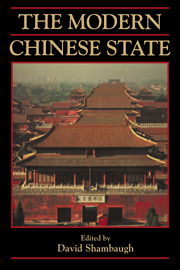Book contents
- Frontmatter
- Contents
- List of Contributors
- List of Illustrations
- List of Abbreviations
- Preface
- Introduction: The Evolving and Eclectic Modern Chinese State
- 1 The Late Imperial Chinese State
- 2 The Chinese State during the Republican Era
- 3 The Evolution of the State in the Republic of China on Taiwan
- 4 The Chinese State during the Maoist Era
- 5 The Chinese State in the Post-Mao Era
- 6 The Chinese Communist Economic State in Comparative Perspective
- 7 The Future of the Chinese State
- Index
3 - The Evolution of the State in the Republic of China on Taiwan
Published online by Cambridge University Press: 15 October 2009
- Frontmatter
- Contents
- List of Contributors
- List of Illustrations
- List of Abbreviations
- Preface
- Introduction: The Evolving and Eclectic Modern Chinese State
- 1 The Late Imperial Chinese State
- 2 The Chinese State during the Republican Era
- 3 The Evolution of the State in the Republic of China on Taiwan
- 4 The Chinese State during the Maoist Era
- 5 The Chinese State in the Post-Mao Era
- 6 The Chinese Communist Economic State in Comparative Perspective
- 7 The Future of the Chinese State
- Index
Summary
From the vantage point of 2000, Taiwan is widely seen as a textbook case of successful economic development and of peaceful transformation from authoritarian rule to democracy. It has drawn the attention of scholars and politicians who see it as a potential model for other developing countries, not least of all the People's Republic of China (PRC). But this was not always so. After Chiang Kai-shek moved the Nationalist government to Taiwan in 1949, he created a strong authoritarian state which repressed domestic aspirations for political change. Although Taiwan's rapid economic modernization began in the late 1950s, its notable economic success was matched by its continued authoritarian political system and the deterioration of its international standing. Until a decade ago, most observers saw little hope of its political transformation or its renaissance as an international player. Indeed, it has only been in the past ten years that one could describe Taiwan as a model of political development and be taken seriously.
The evolution of the state on Taiwan has been shaped by an uneasy amalgam of traditions from imperial China, legacies of the Nationalist era, distinctive qualities of Taiwan's political economy and social structure, and the consequences of development itself. The relative importance of each of these factors has varied over time, but each has made an impact on the structure of the state, its goals, and its performance. Over time, the legacies of the past diminished in importance, and the issues of the present began to dominate. Indeed, it was the willingness of the Guomindang (GMD) to shed its traditional orientations that allowed it to adapt to the changing domestic and international environments it faced.
- Type
- Chapter
- Information
- The Modern Chinese State , pp. 73 - 104Publisher: Cambridge University PressPrint publication year: 2000



